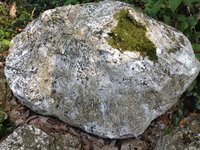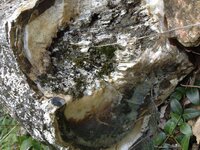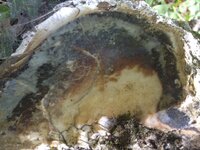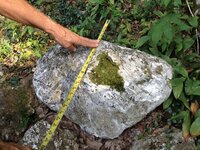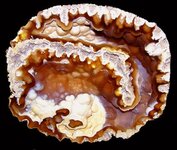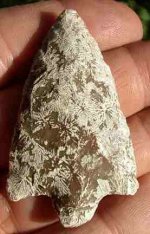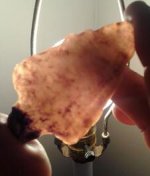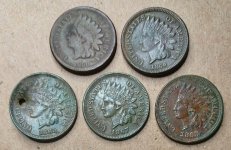You are using an out of date browser. It may not display this or other websites correctly.
You should upgrade or use an alternative browser.
You should upgrade or use an alternative browser.
Petrified wood
- Thread starter Ivybridge
- Start date
Age_old
Sr. Member
- Jul 30, 2012
- 316
- 63
- Detector(s) used
- Bounty Hunter
- Primary Interest:
- All Treasure Hunting
Cool find. To me, it looks like it is actually fossilized coral. You can see the polyps on it. Petrified wood that size isn't usually found in Florida. As for cleaning it, I just use warm water and a toothbrush on all my coral finds. It looks like that might take a while for your find, though. Lol
- Thread starter
- #3
Thanks... it was found a good 30+ years ago dumped out in an orange grove so it could be from any where. I wish I could of gotten better photos, especially the bottom side.
Edited to add: It was found it in grove about 55 years ago... we've just had it the past 30 or so years.
Edited to add: It was found it in grove about 55 years ago... we've just had it the past 30 or so years.
Attachments
Last edited:
Harry Pristis
Bronze Member
It does appear to be agatized coral from the Westcentral part of Florida. It's probably about 25 million years old -- from the Tampa Formation. This material is much in demand by flint-knappers, I think.
You can soak it in a laundry bleach solution to clean it up -- the coral won't be damaged. Or, you could use a pressure washer at your local car-wash (which may remove some weakened crumbs).
You can soak it in a laundry bleach solution to clean it up -- the coral won't be damaged. Or, you could use a pressure washer at your local car-wash (which may remove some weakened crumbs).
Last edited:
Harry Pristis
Bronze Member
Agatized coral is the official Florida state gemstone. The most highly prized specimens are geodized, with crystal or 'colloform' ('hill-like' or bubble-like) chalcedony. Here's an example from Tampa Bay:
Many of the corals, mollusks, and other taxa of the Tampa Formation with shells or skeletons of calcium carbonate have been subjected to complete or partial silicification. This replacement has produced specimens of considerable beauty and sometimes of faithfully reproduced pseudomorphs. Most often the original calcareous structure has been partially or wholly dissolved, and the replacing silica obscures identification of the taxon.
The process of dissolution of the calcium carbonate and the precipitation of the cryptocrystalline quartz (chalcedony) in Ballast Point corals is described by Lund in his 1960 paper "Chalcedony and Quartz Crystals in Silicified Corals.' Lund says of the corals:
The silicified coral masses from Ballast Point are of varying sizes and shapes. Some are
globose and range up to a foot in diameter, some are tubular, and others are irregular in
shape. Many of the masses are hollow, and the preserved 'shell' is characteristically
comprised of two distinct layers. The outer layer consists of replaced coral in which the
features [may be] preserved in remarkable detail, and the inner part consists of either
banded chalcedony or banded chalcedony over which quartz crystals have grown. Most of the
hollow forms are lined with colloform chalcedony, a few are lined with small quartz crystals,
and less commonly specimens are partitioned and lined with both kinds of material, each in a
separate chamber.
The origin of the dissolved silica is plants and animals as diatoms, radiolarians, and silica-secreting sponges, as well as other siliceous matter occuring in the matrix.
For more information see:
Lund, Ernest H., Chalcedony and Quartz Crystals in Silicified Coral; American Minerologist (1960) volume 45, nos. 11-12, pp 1304-1307.
Weisbord, Norman E., New and Little-known Corals from the Tampa Formation of Florida: Bulletin No. 56, Florida Department of Natural Resources (1973).
AGATIZED CORALS FROM THE TAMPA FORMATION OF FLORIDA
The Early Miocene (25mybp) Tampa Formation underlies much of Florida. It is composed of soft, highly-fossiliferouslimestones intermixed with sand and clay. There are several widely-separated exposures of the Tampa limestones which produce silicified corals and mollusks, the best known of which is Ballast Point on Tampa Bay. Nearby exposures of the same formation, such as at Sixmile Creek on Tampa Bay, may produce only calcareous specimens.Many of the corals, mollusks, and other taxa of the Tampa Formation with shells or skeletons of calcium carbonate have been subjected to complete or partial silicification. This replacement has produced specimens of considerable beauty and sometimes of faithfully reproduced pseudomorphs. Most often the original calcareous structure has been partially or wholly dissolved, and the replacing silica obscures identification of the taxon.
The process of dissolution of the calcium carbonate and the precipitation of the cryptocrystalline quartz (chalcedony) in Ballast Point corals is described by Lund in his 1960 paper "Chalcedony and Quartz Crystals in Silicified Corals.' Lund says of the corals:
The silicified coral masses from Ballast Point are of varying sizes and shapes. Some are
globose and range up to a foot in diameter, some are tubular, and others are irregular in
shape. Many of the masses are hollow, and the preserved 'shell' is characteristically
comprised of two distinct layers. The outer layer consists of replaced coral in which the
features [may be] preserved in remarkable detail, and the inner part consists of either
banded chalcedony or banded chalcedony over which quartz crystals have grown. Most of the
hollow forms are lined with colloform chalcedony, a few are lined with small quartz crystals,
and less commonly specimens are partitioned and lined with both kinds of material, each in a
separate chamber.
The origin of the dissolved silica is plants and animals as diatoms, radiolarians, and silica-secreting sponges, as well as other siliceous matter occuring in the matrix.
For more information see:
Lund, Ernest H., Chalcedony and Quartz Crystals in Silicified Coral; American Minerologist (1960) volume 45, nos. 11-12, pp 1304-1307.
Weisbord, Norman E., New and Little-known Corals from the Tampa Formation of Florida: Bulletin No. 56, Florida Department of Natural Resources (1973).
Last edited:
- Thread starter
- #7
Thank you for the information. 
Would love to see what the inside of this looks like. We had always tried off and on to find someone to slice it but no luck due to the size of it. I'll have to keep trying.

Would love to see what the inside of this looks like. We had always tried off and on to find someone to slice it but no luck due to the size of it. I'll have to keep trying.
- Thread starter
- #8
Thank you for the information. 
Would love to see what the inside of this looks like. We had always tried off and on to find someone to slice it but no luck due to the size of it. I'll have to keep trying.

Would love to see what the inside of this looks like. We had always tried off and on to find someone to slice it but no luck due to the size of it. I'll have to keep trying.
Top Member Reactions
-
 2586
2586 -
 1145
1145 -
 1051
1051 -
 905
905 -
 887
887 -
 849
849 -
 803
803 -
 694
694 -
 642
642 -
 544
544 -
 490
490 -
 475
475 -
 474
474 -
 464
464 -
 462
462 -
O
441
-
 423
423 -
 392
392 -
 381
381 -
 363
363
Users who are viewing this thread
Total: 2 (members: 0, guests: 2)
